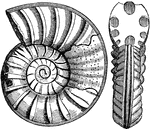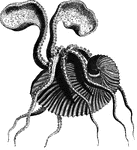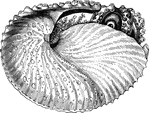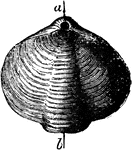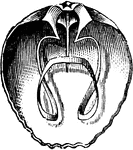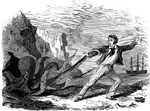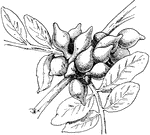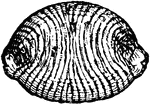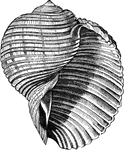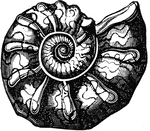
Ammonite
"They were of various forms, but they were of carnivorous habits, resembling the speias, and, like the…
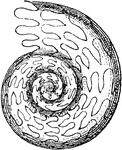
Ammonoid
"Goniatites henslowi. GONIOTITES. A genus of fossil ammonites, giving name to the family Goniatitidae,…
Lingula anatina
"The Lingula anatina has a long peduncle issuing from between the umbones. The valves are nearly…

Aplysia Nervous System
"Nervous System of the Aplysia, a Gasteropodous Mollusc: c, cerebral ganglia; g, thoracle or sub-aesophageal…
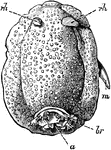
Archidoris Tuberculata
"Doris (Archidoris) tuberculata. a, anus; br, branchiae; m, penis; rh, rh, tentacles." -Parker, 1900
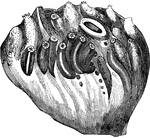
Compound ascidians
"The compound ascidians, or Botryllidae, are united togetyher by the coalescence of of their…
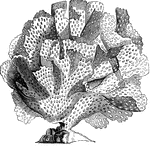
Compound Ascidians
"The compound ascidians, or Botryllidae, are united togetyher by the coalescence of of their…

Social Ascidians
"The Clavellinidae, or Social Ascidians, are united by means of a sort of creeping…

Panopaea australis
"The Panopaea Australis is a large analogous species, found at Port Natal, on the coast of…
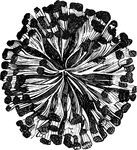
Flustra, avicularia
"The common Flustrae, or Sea-mats, are flat and foliaceous in their form, presenting…
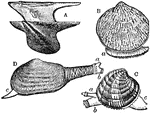
Forms of Bivalves
"Several Forms of Bivalves. A, Avicula; B, Pectunculus, with extended foot (a); C, Venus, with respiratory…

Clio borealis
"The species of the genus Clio, belonging to this order, exist in prodigious numbers in the…
Loligo brevipinna
"A small species, the body three to four inches long, beak prominent and horny; the long arms slender,…

Leach's bursatella
"The descriptions of it are very obscure; it appears to be destitute of shell, the body globular, the…
!["The Pen-Fish or Common Calamary, <em>L. vulgaris</em>, is the best-known species of the genus; the body is somewhat pellucid, of a greenish hue, changeable to dirty brown; the eyes are large and lustrous, of an emerald green, phosphoric, and fiery in a high degree. It is common in the european seas, and was known to the ancient Greeks and Romans. [Shown with a quill pen]" — Goodrich, 1859](https://etc.usf.edu/clipart/14000/14004/cmncalamari_14004_mth.gif)
Common calamari
"The Pen-Fish or Common Calamary, L. vulgaris, is the best-known species of the genus; the…

Carinaria
"The Carinaria has an elongated transparent body, dotted with elevated points, and furnished toward…
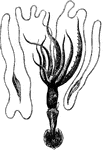
Bonelli's Cheiroteuthis
"Has the body eight inches long, and the longest tentacles nearly three feet." — Goodrich, 1859

Burrowing Clam
"Mya arenaria, a burrowing clam. The siphon is represented as fully extended. This is quickly retracted…
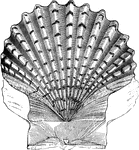
St, James' cockle
"Another species, St. James's cockle, P. Jacobaeus, having been adopted in the Middle Ages…

Scorpion Conch
The scorpion shell (Pteroceras lambis) is a large sea snail in the Strombidae family of conchs.
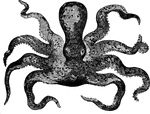
Cuttlefish
"The cuttlefishes have a strange method of walking, head-downward, on their outspread arms; they can…
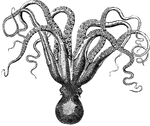
Cuttlefish
"It has no shell, and no skeleton, but has two conical pieces of horny substance imbedded in the back,…

Cuttlefish
"Twelve to eighteen inches long; the skin smooth, whitish, and spotted with brown and purple." —…
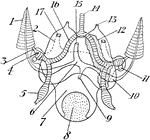
Cuttlefish Circulatory and Excretory Systems
"Diagram of circulatory and excretory systems in a Decapod-like Sepia. 1, Gill; 2, renal sac; 3, afferent…

Cuttlefish Structure
"Diagram of the structure of Sepia. a., Eight short arms around mouth; l.a., one of the two long arms;…

Bone of the cuttle-fish
"An internal support of a calcareous nature, and formed in laminae; this is the well-known cuttlefish…

Common Cuttlefish
The Common Cuttlefish (Sepia officinalis) is a mollusc in the Sepiidae family of cephalopods.

Cytherea dione
"The posterior being besest by spines, and the sides furrowed with elevated lamellæ. The color…

Ampullaria dubia
"The A. dubia is found in the Nile. Several of this genus, brought from Egypt to Paris packed…

Ear-shell
"In these, which are called Ear-Shells, the animal has a shrt muzzle and two branchial plumes;…
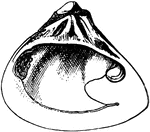
Right Valve of Galatea Bivalve
Galatea reclusa is a species of bivalve mollusk in the Donacidae family of bean clams (wedge shells).

Dorsal View of Gastrochaena
"Dorsal View of Gastrochaena. The ventral view shows the dried mantle with pedal perforation." -Whitney,…

Lateral View of Gastrochaena
"Lateral View of Gastrochaena. The ventral view shows the dried mantle with pedal perforation." -Whitney,…

Ventral View of Gastrochaena
"Ventral View of Gastrochaena. The ventral view shows the dried mantle with pedal perforation." -Whitney,…



